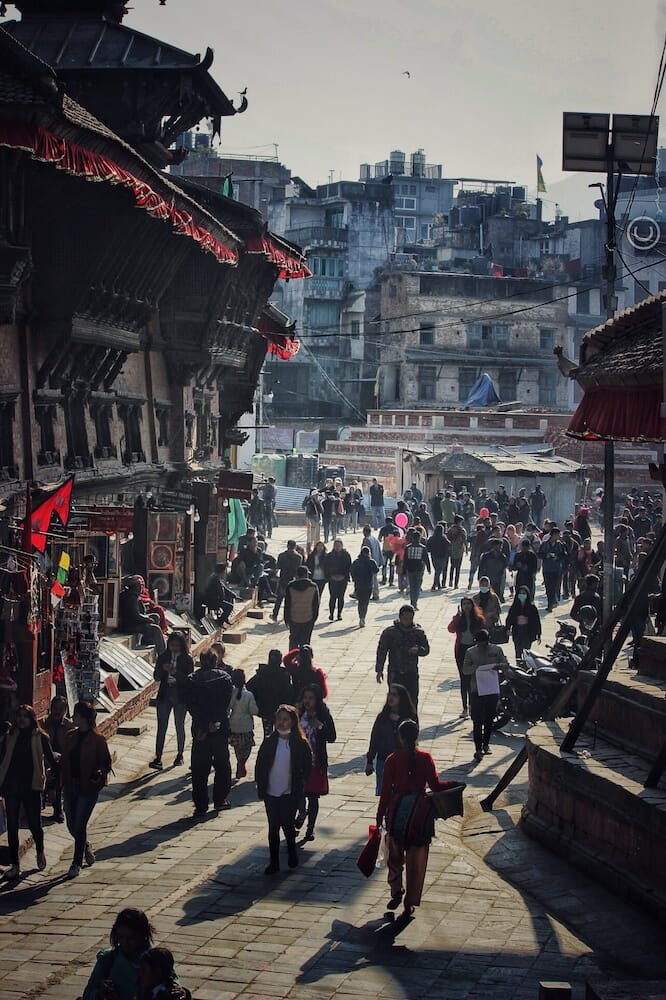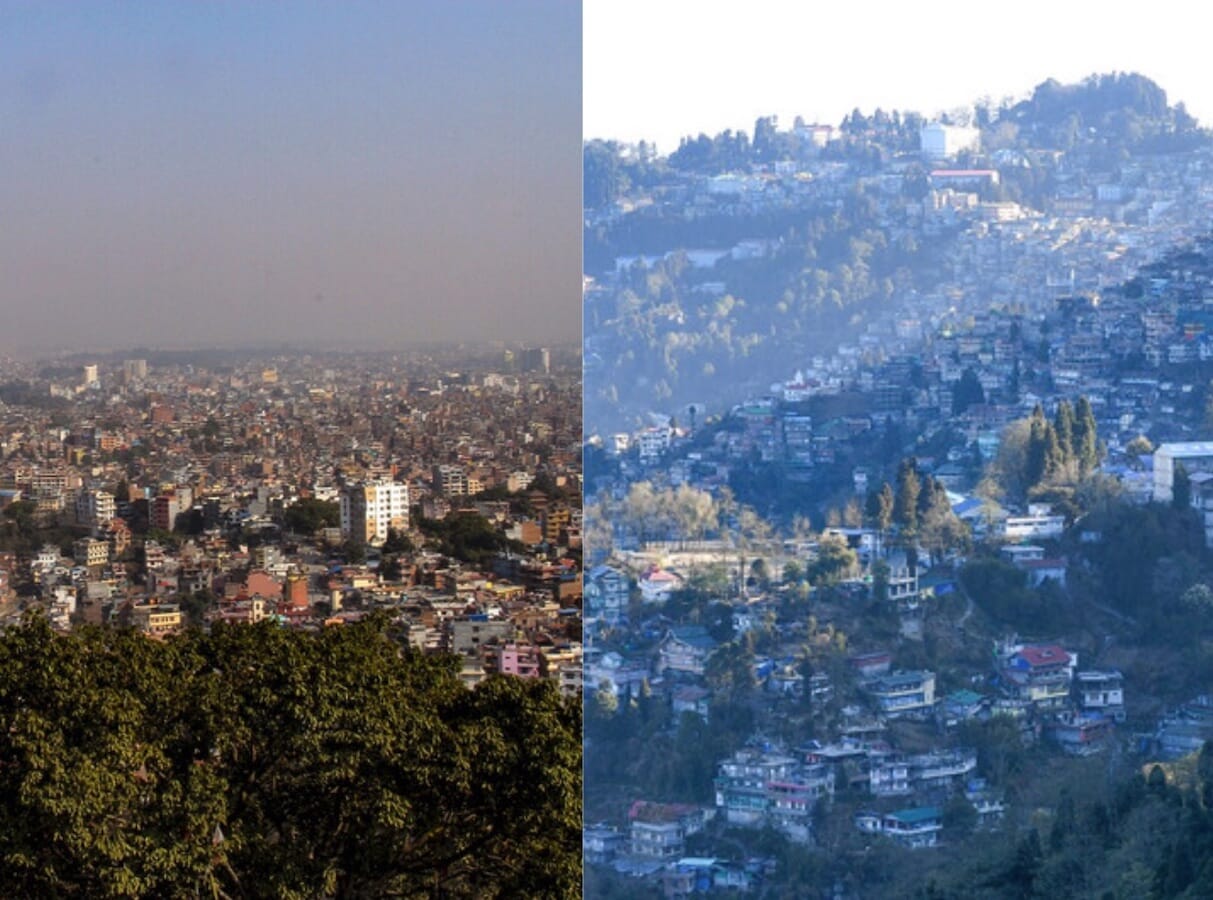How does history seal the fate of urban cities? A comparative study of the urban spaces in Darjeeling and Kathmandu as shaped by their origin.
Kathmandu, the capital city of Nepal, today exists as a dynamically moving metropolis bustling with activity. As a centre of economic movement and administration in Nepal, the valley is abode to many personnel-of-importance and many ordinary humans.
Kathmandu valley’s geological timeline attributes its origin to a lake in the vicinity of Bagmati River, below the Pashupatinath Temple. Legend has it that the lake was drained by Manjushree Bodhisattva’s powers to create the fertile valley where human civilization could flourish.

Image: Sasank Pradhan
The History of Kathmandu has been well documented since the ancient period, precisely between 167 BCE to 1 AD. Architectural grandeur flourished during the beginning of the Licchavi period (7 AD) and reached its Zenith during the Malla Period (15-17 AD). In fact, the Kings of the Malla period seem to be the architects of the current-day Kathmandu. The valley’s arrangement as a trinity of three cities: Kathmandu, Bhaktapur, and Lalitpur, and the centering of these cities around a Durbar also happens to be a gift of the ancient Kings. Kathmandu, at the time, was known to be home to the trading, artisanal Newari people. Ginormous monuments and monumental gateways with intricate wood carvings birthed at the hands of the adept Newari artisans whose skills were discussed as far as Kublai Khan’s courts in present-day Mongolia. When the Gorkha king, Prithvi Narayan Shah took over the Kingdom of Kathmandu, Newari architecture was still revered and continued to flourish under his patronage. However, this was a period of intense fortification and isolation of the Kingdom from foreign invasion. Forts were built at Pulchowk, Chandragiri, Shivapuri, etc by the Gorkhas under Prithivi Naryan Shah.
Kings have conquered and soldiers have been martyred, but the grandeur created by humble Newari artisans stands aloft amidst the modern post-industrial concrete spaces. These symbols of Power and Protection guard the city even as the urban space expands around the busy streets of Kathmandu, casting an unexpected old worldly enchantment on the beholder.
Around 600 km from Kathmandu, in the Eastern Himalayan valleys lay the hills of Darjeeling, India. As an erstwhile part of the Kingdom of Sikkim, and briefly, the Kingdom of Nepal, the ethnicity of the Indian citizens in Darjeeling is primarily Nepali (particularly dominant with the Eastern Himalayan tribes). However, as a place that was forged out of monumental effort and sometimes subtle trickery of the British East India Company, the urban space in Darjeeling is an unmissable reflection of colonial grandeur.
Oral narratives by natives from Darjeeling claim the existence of a lake at the present-day Darjeeling Bazaar. This lake was fed by many mountain springs that exist even today as crucial water sources for the dwellers of Darjeeling.
Darjeeling descends from the highest point of the Mahakal Dara, where the existence of indigenous animist cave-structures, Kirati and Sanatan temples, along with a Buddhist shrine, can be interestingly noted.

Image: Sasank Pradhan
According to historical records, it is precisely this Dara (later named Observatory Hill by the British) that the East- India Company’s officer Captain Lloyd had sought to lease from the Chogyal of Sikkim for building a recuperative sanatorium for the Company’s soldiers in 1829. The Company ended up claiming lands up to the Mahananda River in present-day Siliguri as a “token of friendship” from the Chogyal.
The descent from the Mahakal Dara leads to the Chowrasta, the relic of a colonial bandstand, where Non-British citizens were once forbidden from entering. Today, Chowrasta( Nepali for “ four roads”) stands as the city’s centre point, serving as the focal point of community activities and gatherings.
Current-day Darjeeling is a tourist’s delight where European style eateries, stone-and-timber bungalows, and cottages with attics and eaves sit comfortably on ridges of the upper hills. Here, the administrative centre of the town still resides. The toy train in Darjeeling is another uniquely colonial feature that lends it an old English setting and continues to define the structure of transportation and traffic in Darjeeling.
Further descent leads to the Darjeeling Bazaar, the same place where the fabled lake once stood. With only one primary highway (the Hill cart road) to serve traffic and access in downtown Darjeeling, space becomes suffocating and elusive as the construction becomes compact and industrial. In and around the Chowk Bazaar, British relics such as cable-car stations, labour colonies, storage facilities, and fuel depots can be found amongst the ever-expanding multistoried, sometimes fragile current-day concrete exploits. Further down the valley on the expanses of the Tukvar and Happy Valley townships dwell company relics in the form of tea plantations and pine trees imported from China and Japan.
Although indigenous Lepcha and Limbu tribes have been recorded to occupy the hills of Darjeeling before the advent of the British, their architectural heritage is not as well preserved in the urban setting of Darjeeling.
While Kathmandu exists as an urban space that has preserved the remnants of the Nepali monarchy, the urban landscape of Darjeeling is inadvertently a space that is defined by its formative use as a centre of imperial ambition and exploitation.
This brings us to an important question: Is a city’s landscape forged at the desire of those that hold the Power?
Both Kathmandu and Darjeeling have preserved the heritage of those that held Power at these places. Cities with a history of imperialism and ancient monarchy often note a pattern of overlooking particular spaces owing to hierarchical segregation, economic tactics, safety arrangements, and pompous fancies.
Modern-day cities exist as democratic spaces and continue to grow with the pace of rapid capitalization and globalized ideals. Thus, modern-day city planners may have to accommodate the desires of overlooked histories and spaces while striving to create a sustainable landscape.
Most urban cities grow without severing the umbilical cord of their origin. A nostalgic memory attaches human beings to the past. While Kathmandu Valley today has become a metropolitan centre, it has been struggling to tackle air pollution due to a lack of attention to urban greenery and landscaping. Darjeeling, on the other hand, is ironically still green with tea gardens and pine trees. However, the lack of sustainable space in the ever-expanding urbanscape of hilly Darjeeling is fiercely evident as high rises mushroom overnight in the fragile rocky soils, leaving the place vulnerable to a domino-like apocalypse.
